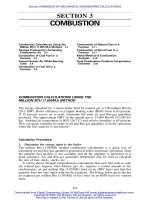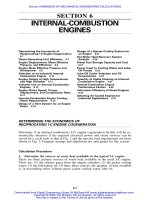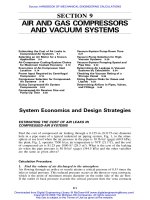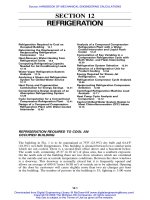Tài liệu Essentials of Human Nutrition Second Edition pdf
Bạn đang xem bản rút gọn của tài liệu. Xem và tải ngay bản đầy đủ của tài liệu tại đây (3.69 MB, 682 trang )
Essentials of Human Nutrition
Second Edition
Oxford University Press makes no representation, express or implied, that the drug
dosages in this book are correct. Readers must therefore always check the product infor-
mation andclinical procedures with the most up-to-date published product information
and data sheets provided by the manufacturers and the most recent codes of conduct
and safety regulations. The authors and the publishers do not accept responsibility or
legal liability for any errors in the text or for the misuse or misapplication of material in
this work.
Essentials of Human
Nutrition
SECOND EDITION
Edited by
Jim Mann
Professor of Human Nutrition, University of Otago, New Zealand
A. Stewart Truswell
Professor of Human Nutrition, University of Sydney, Australia
1
3
Great Clarendon Street, Oxford OX2 6DP
Oxford University Press is a department of the University of Oxford.
It furthers the University’s objective of excellence in research, scholarship,
and education by publishing worldwide in
Oxford New York
Auckland Bangkok Buenos Aires Cape Town
Chennai Dar es Salaam Delhi Hong Kong Istanbul
Karachi Kolkata Kuala Lumpur Madrid Melbourne Mexico City
Mumbai Nairobi S
˜
ao Paulo Shanghai Taipei Tokyo Toronto
and an associated company in Berlin
Oxford is a registered trade mark of Oxford University Press
in the UK and in certain other countries
Published in the United States
by Oxford University Press Inc., New York
© Oxford University Press 2002
The moral rights of the author have been asserted
Database right Oxford University Press (maker)
First edition published 1998
Reprinted 1999 (with corrections), 2000 (twice)
Second edition published 2002
All rights reserved. No part of this publication may be reproduced, stored
in a retrieval system, or transmitted, in any form or by any means, without
the prior permission in writing of Oxford University Press, or as expressly
permitted by law, or under terms agreed with the appropriate
reprographics rights organization. Enquiries concerning reproduction
outside the scope of the above should be sent to the Rights Department,
Oxford University Press, at the address above
You must not circulate this book in any other binding or cover
and you must impose this same condition on any acquirer
A catalogue record for this title is available from the British Library.
Library of Congress Cataloging in Publication Data
(Data available)
ISBN 0 19 850861 1 (Pbk)
10987654321
Typeset by Newgen Imaging Systems (P) Ltd., Chennai, India
Printed in Great Britain
on acid-free paper by Biddles Ltd, Guildford & King’s Lynn
Preface to the Second Edition
We and our contributors are very pleased that Essentials of Human Nutrition has estab-
lished itself as a reliable and reader-friendly textbook for students embarking on courses
in human nutrition. It has been adopted as a human nutrition course textbook in sev-
eral countries, and has proven a useful reference work for medical students, doctors and
other health professionals requiring up-to-date, authoritative information on the role
of nutrition in human health.
Nutrition research and interpretations of it do not stand still. To ensure the infor-
mation remains as current as possible we and Oxford University Press have produced
this thoroughly revised and updated second edition, three years after the successful first
edition—something which is not possible with larger textbooks. All sections have been
revised and new chapters added, including one on the topical issue of Functional Foods.
This Second Edition has seven new contributors, with contributors coming from
Australia, Canada, Germany, The Netherlands, New Zealand, South Africa, and the
United Kingdom. We are very grateful to our contributors for their expertise and
cooperation.
Jim Mann
Stewart Truswell
November 2001
This page intentionally left blank
Contents
Contributors xi
Acknowledgements xiv
Permissions xv
Dedication xix
1 Introduction 1
Stewart Truswell and Jim Mann
Part 1 Energy and macronutrients
2 Carbohydrates 11
Janette Brand-Miller
3 Lipids 31
Jim Mann and Murray Skeaff
4 Protein 55
Alan Jackson
5 Energy 79
Joop van Raaij
6 Alcohol 97
Stewart Truswell
Part 2 Organic and inorganic essential nutrients
7 Water, electrolytes and acid–base balance 113
James Robinson
8 Major minerals: calcium and magnesium 129
8.1 Calcium 129
Ailsa Goulding
8.2 Magnesium 141
Marion Robinson
9 Iron 145
Patrick MacPhail
10 Trace elements 159
10.1 Zinc 159
Samir Samman
viii CONTENTS
10.2 Copper 164
Samir Samman
10.3 Iodine 166
Christine Thomson
10.4 Selenium 172
Christine Thomson
10.5 Fluoride 181
Stewart Truswell and Marion Robinson
10.6 Ultratrace elements 186
Rosalind Gibson
11 Vitamin A and carotenoids 189
Clive West
12 The B vitamins 209
Stewart Truswell and Robyn Milne
13 Vitamins C and E 231
Murray Skeaff
14 Vitamins D and K 249
Stewart Truswell
15 Other biologically active substances in plant foods 259
Claus Leitzmann
Part 3 Nutrition-related disorders
16 Overweight and obesity 273
Ian Caterson
17 Protein-energy malnutrition 289
Stewart Truswell
18 Cardiovascular diseases 299
Jim Mann
19 Diet and cancer causation 335
Sheila Bingham
20 Diabetes mellitus 355
Jim Mann
21 The eating disorders: anorexia nervosa and bulimia nervosa 371
Christopher Fairburn
Part 4 Foods
22 Food groups 383
Margaret Allman-Farinelli
22.1 Breads and cereals 383
Trish Griffiths
CONTENTS
ix
22.2
Legumes 387
Sue Munro
22.3 Nuts and seeds 389
Sue Munro
22.4 Fruit 390
Stewart Truswell
22.5 Vegetables 392
22.6 Milk and milk products 394
Soumela Amanatidis
22.7 Meat and poultry 397
22.8 Fish 399
Samir Samman
22.9 Eggs 400
22.10 Fats and oils 401
Ron Bowrey
22.11 Fat replacers 404
22.12 Herbs and spices 405
Sue Munro
22.13 Sweeteners: nutritive and non-nutritive 407
Janette Brand-Miller
22.14 Food processing 408
Stewart Truswell
23 Food toxicity and safety 415
Peter Williams
Part 5 Nutritional assessment
24 Food analysis and food composition tables 435
Philippa Lyons-Wall
25 Dietary assessment 449
Rosalind Gibson
26 Determining nutritional status 467
Rosalind Gibson
Part 6 Life stages
27 Pregnancy and lactation 501
Patsy Watson and Clare Wall
28 Infant feeding 513
Donna Secker and Stanley Zlotkin
29 Childhood and adolescence 529
Cynthia Tuttle and Stewart Truswell
30 Sports nutrition 541
Louise Burke
x CONTENTS
31 Nutrition and ageing 551
Caroline Horwath
Part 7 Clinical and public health
32 Food habits 569
Helen Leach
33 Nutritional recommendations for the general population 577
Stewart Truswell
34 Nutrition promotion for communities 593
Judy Sheeshka
35 Dietary counselling 601
Paula Hunt
Part 8 Case studies
36 Nutritional consequences of poverty in developed countries 613
Winsome Parnell
37 Enteral and parenteral nutritional support 623
Madeleine Ball
38 Functional foods 633
Martijn Katan
Index 643
Contributors
Margaret Allman-Farinelli, PhD,
Dip Nutr Diet
Nutrition Consultant,
Sydney NSW 2006,
Australia
Soumela Amanatidis, BSc.,
Dip Nutr Diet
Community Nutritionist,
Central Sydney Area Health Service,
Queen Mary Building,
Grose Street, Camperdown 2050 NSW,
Australia
Madeleine J. Ball, MD, MRCP, FRCPath
Professor and Head, School of Biomedical
and Human Life Sciences,
University of Tasmania,
Launceston, Tasmania 7250,
Australia
Sheila Bingham, BSc, MA, PhD
Deputy Director,
MRC Dunn Human Nutrition Unit,
Welcome Trust/MRC Building,
Cambridge, United Kingdom
Ron Bowrey, BE, PhD
Research Director,
Meadow Lea Foods Ltd, Locked Bag 2222,
North Ryde NSW 2113,
Australia
Janette C. Brand-Miller, BSc, PhD
Professor,
Human Nutrition Unit G08,
University of Sydney 2006 NSW,
Australia
Louise M Burke, PhD, BSc (Nutr),
Grad Dip Diet
Head of Department of Sports Nutrition,
Australian Institute of Sport,
Bruce ACT,
Australia
Ian Caterson, MB, BS, PhD, FRACP
Boden Professor of Human Nutrition,
Human Nutrition Unit G08,
University of Sydney 2006 NSW,
Australia
Christopher Fairburn, DM, MPhil, FRCPsych
Wellcome Principal Research
Fellow and Professor,
Department of Psychiatry,
University of Oxford,
Oxford, United Kingdom
Rosalind S. Gibson, BSc, MS, PhD
Professor in Human Nutrition,
Department of Human Nutrition,
University of Otago,
Dunedin, New Zealand
Ailsa Goulding, BSc, PhD
Professorial Research Fellow,
Department of Medicine,
Otago Medical School,
Dunedin, New Zealand
Trish Griffiths, BSc, Dip Nutr Diet
Nutrition Manager,
Bread Research Institute,
North Ryde 2113 NSW,
Australia
xii CONTRIBUTORS
Caroline Horwath, BSc, PhD
Senior Lecturer in Human Nutrition,
Department of Human Nutrition,
University of Otago,
Dunedin, New Zealand
Paula Hunt, BSc (Hons)
State Registered Dietitian,
Public Health Nutritionist,
Independent Nutrition Consultant,
Westwood Lodge,
Wells Road, Ilkley,
West Yorkshire,
United Kingdom
Alan A. Jackson, MA, MD,
FRCP, MRCPCH
Professor of Human Nutrition,
Institute of Human Nutrition,
University of Southampton,
United Kingdom
Martijn B. Katan, PhD
Wageningen Centre for Food Sciences
and Division of Human Nutrition and
Epidemiology,
Wageningen University,
Bomenweg 2, Wageningen,
The Netherlands
Helen M. Leach, MS, PhD
Associate Professor in Anthropology,
Department of Anthropology,
University of Otago,
Dunedin, New Zealand
Claus Leitzmann, BSc, MSc, PhD
Professor of Human Nutrition,
Institut f
¨
ur Ern
¨
ahrungswissenschaft,
University of Giessen,
Germany
Philippa Lyons-Wall, PhD, Dip Nutr Diet
Lecturer, Human Nutrition Unit G08,
University of Sydney 2006 NSW,
Australia
A. Patrick MacPhail, MB, BCh,
PhD, FCP
Professor of Medicine,
Medical School,
University of the Witwatersrand,
Johannesburg, South Africa
Jim I. Mann, MA, DM, PhD,
FRACP, FRSNZ
Professor in Human Nutrition
and Medicine,
Department of Human Nutrition,
University of Otago,
Head of Endocrinology,
Dunedin Hospital,
Dunedin, New Zealand
Robyn Milne, BSc (Hons), PhD
Lecturer in Human Nutrition,
Department of Human Nutrition,
University of Otago,
Dunedin, New Zealand
Sue Munro, BSc, Dip Nutr Diet
Associate Lecturer,
Human Nutrition Unit G08,
University of Sydney 2006 NSW,
Australia
Winsome R. Parnell, BHSc, MSc
Senior Lecturer in Human Nutrition
Department of Human Nutrition
University of Otago,
Dunedin, New Zealand
James Robinson, MD, ScD,
FRACP, FRSNZ
Emeritus Professor in Physiology,
Department of Physiology,
Otago Medical School,
Dunedin, New Zealand
Marion Robinson, CBE, MHSc,
PhD, FNIC, FRSNZ, FIUNS
Emeritus Professor in
Human Nutrition,
Department of Human Nutrition,
University of Otago,
Dunedin, New Zealand
CONTRIBUTORS
xiii
Samir Samman, BSc, PhD
Senior Lecturer,
Human Nutrition Unit G08,
University of Sydney 2006 NSW,
Australia
Donna Secker, MSc
Registered Dietitian,
Clinical Dietitian,
Hospital for Sick Children,
Toronto, Ontario,
Canada
Judy Sheeshka, PhD
Registered Dietitian,
Associate Professor,
Department of Family Relations
and Applied Nutrition,
University of Guelph,
Guelph, Ontario N1G 2W1,
Canada
C. Murray Skeaff, BSc., PhD
Senior Lecturer in Human Nutrition,
Department of Human Nutrition,
University of Otago,
Dunedin,
New Zealand
Christine D. Thomson, MHSc, PhD
Associate Professor,
Department of Human Nutrition,
University of Otago,
Dunedin,
New Zealand
A. Stewart Truswell, AO, MD, DSc,
FRCP, FIUNS
Professor of Human Nutrition,
Human Nutrition Unit G08,
University of Sydney 2006, NSW,
Australia
Cynthia R. Tuttle, BSc, PhD, MPH
Lecturer,
Department of Nutrition and Food Science,
University of Maryland,
College Park, MD 20742,
USA
Joop van Raaij, PhD
Lecturer,
Department of Human Nutrition,
Wageningen Agricultural University,
6700 EV Wageningen,
The Netherlands
Clare R. Wall, BSc, MApplSci, PhD
Senior Lecturer,
InstituteofFood,Nutrition
and Human Health,
Massey University
Albany Campus, Auckland,
New Zealand
Patsy Watson, BHSc, MHSc
Programme Leader in Human
Nutrition,
InstituteofFood,Nutrition
and Human Health,
Massey University, Albany Campus,
Auckland, New Zealand
Clive West, PhD, DSc
Professor,
Department of Human Nutrition
and Epidemiology,
Wageningen Agricultural
University,
6700 EV Wageningen,
The Netherlands
Peter Williams, PhD, Dip Nutr Diet
SeniorLecturerinNutrition
and Dietetics,
Department of Biomedical Science,
University of Wollongong,
New South Wales, Australia
Stanley H. Zlotkin, MD, PhD
Professor,
Departments of Paediatrics and
of Nutritional Sciences,
Faculty of Medicine,
University of Toronto and
Research Institute and
Division of Gastroenterology
and Nutrition,
Hospital for Sick Children,
Toronto, Ontario, Canada
Acknowledgements–2nd edition
Many people have made substantial contributions towards the production of this book,
but some warrant special mention. Professors Marion and James Robinson and Rosalind
Gibson have been involved with this project from its inception. In the Sydney office
Marianne Alexander provided secretarial support. Many of the figures were drawn by
Peter Scott.
Miss Beth Gray acted as editorial assistant. She typed many of the chapters and
amended most of the others after the editorial process. She also had the unenviable task
of converting the entire text and tables into a standardized format. We are immensely
grateful to her for this key role in the production of this book.
We are, last but not least, grateful to our families who have been tolerant and support-
ive of ourselves and this project, which was more time consuming than we imagined it
would be when we first embarked upon it.
Permissions
Table 2.1: Adapted, with permission, from Asp N-G. (1994) Nutritional classification and analysis of
food carbohydrates. Am J Clin Nutr, 59(suppl.), 679S–81S.
Table 2.2: Reproduced with permission: Englyst, H.N. et al. (1994) Classification and measurement of
nutritionally important starch fraction. Europ J Clin Nutr, 46, S33–50.
Table 2.3: Reprinted with permission of Macmillan Press Ltd, from Woodward, M. and Walkar, A.R.P.
(1994) Sugar consumption and dental caries: evidence from 90 countries. Br Dent J, 176, 297–302.
Table 2.4: Foster-Powell, K. and Brand Miller, J. (1995) International tables of glycemic index. Am J
Clin Nutr, 62, 871S–893S.
c
Am J Clin Nutr American Society for Clinical Nutrition.
Table 3.2, 3.3, 8.2, 13.2, 13.5, 22.6: Reproduced with permission of NZ Institute for Crop & Food
Research Limited. A Crown research institute.
Figure 5.3: Reprinted with permission of Macmillan Press Ltd, from Murgatroyd, P.R., et al. (1993)
Techniques for the measurement of human energy and expenditure: a practical guide. Int J Obesity,
17, 549–68.
Table 5.7 Reprinted with permission of World Health Organization, from: FAO/WHO/UNU (1985)
Energy and protein requirements, Technical report series No. 724.
Table 6.2: Reprinted with permission. Boffeta, P. and Garfinkel, L. (1990) Alcohol drinking and
mortality among men enrolled in an American Cancer Society Prospective Study. Epidemiology,
1, 342–48.
Table 7.1: Adapted, with permission of Blackwell Science Ltd from Bray, J.J., et al. (1994) Lecture notes
on Human physiology (3rd edition).
Box 7.1: Reproduced with permission of GP Publications. Wellington, New Zealand.
Table 9.2: Reprinted with permission of Food and Agriculture Organization of the United Nations, from
Food and Nutrition Series No. 23, 1988—Requirements of vitamin A, iron, folate, and vitamin B12.
Figure 10.1: Reproduced with permission of Cambridge University Press from: Hercus, C.E., et al.
(1925) Endemic goitre in New Zealand and its relation to soil iodine. J Hygiene, 24 321–402.
Figure 10.2: Reproduced with permission of ILSI Press Ltd, from Levander, O.A. and Burk, R.F. (1996).
Present Knowledge of Nutrition, Seventh edition.
Figure 10.3: Thomson, C.D. and Robinson, M.F. (1980) Blood selenium levels report in healthy adults
reported in various countries. Am J Clin Nutr, 33, 303–23.
c
Am J Clin Nutr American Society for
Clinical Nutrition.
Figure 10.4: Reprinted with permission of the British Journal of Nutrition.
Table 10.2: Reproduced with permission of World Health Organisation, from WHO (1994) Indicators
for assessing iodine deficiency disorders and their control through salt iodization.
xvi PERMISSIONS
Table 10.3: Reprinted with permission of Australian Professional Publications, from Dreosti, I. (1990)
Recommended nutrient intakes, Australian Papers.
Figure 18.2: Cardiovascular Epidemiology Unit, University of Dundee, UK, 1994.
Figure 18.3: Beaglehole, R. (1999) International trends in coronary heart disease mortality and incidence
rates
c
Journal Cardiovascular Risk, 6, 63–8.
Figure 18.4: Reprinted with permission of the publisher from Seven Countries: a multivariate analysis
of death and coronary heart disease by Ancel Keys, Cambridge, MA. Harvard University Press,
Copyright
c
1980 by the Presidents and Fellows of Harvard College.
Figure 18.5: Martin, M.J., et al. (1986) Serum cholesterol, blood pressure and mortality: implications
from a cohort of 361662 men. 2, 933–6. The Lancet.
Figure 18.7: Ulbricht, T.L.V. and Southgate, D.A.T. (1991) Coronary heart disease: seven dietary factors.
The Lancet, 338, 985–92.
Figure 18.8: Reprinted with permission of World Health Organization, from Technical Report Series
678, Prevention of coronary heart disease, 1982.
Figure 18.9: Reprinted with permission of Nature Medicine, New York, USA.
Figure 18.10: Appel, L.J., et al. (1997) A clinical trial of the effects of dietary patterns on blood pressure
c
New England Journal of Medicine, 336, 1117–24.
Figure 18.11: Beilin, L.J., et al. (1988) Vegetarian diet and blood pressure levels: incidental or
causal association? Am J Clin Nutr, 48,
c
806–10. Am J Clin Nutr American Society for Clinical
Nutrition.
Table 18.3 Weatherall, D., et al. (1987) Disorders of lipid transport. In Oxford textbook of medicine (2nd
edition). By permission of Oxford university Press, Oxford.
Table 18.5: Department of Health. Dietary reference values for food energy and nutrients for the United
Kingdom. 1991, No. 41. Crown copyright is reproduced with the permission of the Controller of Her
Majesty’s Stationery Office.
Figure 19.1: Reproduced with permission of International Agency for Research on Cancer, World Health
Organization.
Figure 19.2: Reproduced with permission of International Agency for Research on Cancer, World Health
Organization.
Figure 19.5: Reproduced with permission of Cell Press, Cambridge MA, USA.
Figure 19.6: Reproduced with permission of the British Journal of Nutrition.
Figure 20.2 Reproduced with permission of World Health Organization.
Figure 20.3: Reprinted with permission, from: Knowler, W.C. et al. (1981) Diabetes incidence in Pima
Indians: contributions of obesity and parental diabetes. Am J Epidemiol, 113, 144–56.
Figure 20.4: Reprinted with permission, from Salmer
´
on, J., et al. (1997) Dietary fiber, glycemeic load,
and risk of non-insulin-dependent diabetes mellitus in women.
c
JAMA, 277, 472–7.
PERMISSIONS
xvii
Figure 20.6: Toeller, M. et al. (1996) Nutritional intake of 2868 IDDM patients from 30 centres in
Europe. Diabetologia 39, 929-39.
c
Springer-Verlag GmbH & Co. KG.
Table 22.1: Reprinted by courtesy of Marcel Dekker Inc., from Lorenz, K.J. and Kulp, K. (eds.) (1991)
Handbook of cereal science and technology.
Table 22.1: Reprinted with permission from: Mugford, D.C. and Batey, I.L. Composition of Australian
flour mill products from bakers’ wheat grist. Food Australian; 1995. Bread Research Institute of
Australian; and Mugford D. Nutritional composition of Australian wheat and bakers’ flour. Bakers
and Millers Journal, 1983; February.
Tables 22.2, 22.5, 22.8, 22.9, 22.14: English, R. and Lewis, J. The composition of foods Australia, AGPS,
Canberra: Commonwealth of Australian copyright reproduced with permission.
Tables 22.3, 22.4, 22.7, 22.8, 22.14: Data from the Composition of Foods 5th edition and supplements
are reproduced with the permission of The Royal Society of Chemistry and the Controller of Her
Majesty’s Stationery Office.
Table 23.3: Reprinted from the Journal of Food Protection 1993; 56, 1077, with permission of the
International Association of Milk, Food and Environmental Sanitarians, 6200 Aurora Avenue, Suite
200W, Des Moines, IA 50322-2863; 515-276-3344; US or Canada: 800-369-6337; Fax: 515-276-8655.
Table 24.4: English, R and Lewis, J. Nutritional values of Australian foods, Canberra, AGPS (AOAC
Prosky and Asp 2, method of estimating dietary fibre content of dried kidney beans). Commonwealth
of Australia copyrights reproduced with permission.
Table 24.7: Reproduced with permission of Academic Press Inc., Orlando, Florida, USA.
Figure 25.3: Adapted from Nutrition recommendations, Health Canada, 1997. With permission.
Table 25.4: Modified with permission from: Block, G., (1986) et al. A data-based approach to diet
questionnaire design and testing. AmJEpid, 124, 434–69.
Table 25.6: Beaton (1985) Uses and limits of the use of the Recommended Dietary Allowances for
evaluating dietary intake data. Am J Clin Nutr, 41, 155–64.
c
Am J Clin Nutr American Society for
Clinical Nutrition.
Table 26.1: Reprinted with permission of Macmillan Press Ltd, from: Ferro-Luzzi, A. (1992) A simplified
approach of assessing adult chronic enery deficiency. Euro J Clin Nutr, 1992; 46, 173–86.
Table 26.3: Reprinted with permission of Mosby-Year Book Inc., St. Louis, MO, USA.
Table 26.4: Adapted with permission of the American Public Health Association and adapted from:
Cristakis, G. (1973) Nutritional assessment in health programs: physical signs and symptoms related
malnutrition. Am J Pub Health, 63, 1–82.
Tables 29.1, 29.2, 29.4: Crown copyright is reproduced with the permission of the Controller of Her
Majesty’s Stationery Office.
Figure 29.2: Reprinted with permission of Mosby-Year Book Inc., St. Louis, MO, USA.
Table 31.1: Reprinted with permission of Ambio.
Figure 31.2: Reprinted with permission of Plenum Publishing Corp, New York, NY, USA.
Figure 31.3: Reprinted with permission of The Gerontological Society of America, from McGandy, R.B.
et al. (1966) Nutrient intakes and energy expenditure in men of different ages. J Geront, 21, 581–7.
xviii PERMISSIONS
Figure 31.4: Holick, M. (1994) Vitamin D—new horizons for the 21st century. Am J Clin Nutr, 60,
619–30.
c
Am J Clin Nutr American Society for Clinical Nutrition.
Figure 35.1: Adapted from Prochaska, J.O. and Diclemente, C. (1986) Towards a comprehensive model
of change. In Miller, W.R. and Meather, N. (eds) Treating Addictive Behaviours: processes of change.
Plenum, New York, USA.
Dedication
The Editors would like to dedicate this book to Marion Robinson, whose
outstanding contribution to teaching and research in human nutrition is
acknowledged.
This page intentionally left blank
Chapter 1
Introduction
Stewart Truswell and Jim Mann
1.1 Definition
This book is about what we consider the essentials of human nutrition.
The science of human nutrition deals with all the effects on people of any component
found in food. This starts with the physiological and biochemical processes involved
in nourishment—how substances in food provide energy or are converted into body
tissues, and the diseases that result from insufficiency or excess of essential nutrients
(malnutrition). The role of food components in the development of chronic degener-
ative disease like coronary heart disease, cancers, dental caries, etc., are major targets
of research activity nowadays. The scope of nutrition extends to any effect of food on
human function: fetal health and development, resistance to infection, mental function
and athletic performance. There is growing interaction between nutritional science and
molecular biology which may help to explain the action of food components at the
cellular level and the diversity of human biochemical responses.
Nutrition is also about why people choose to eat the foods they do, even if they have
been advised that doing so may be unhealthy. The study of food habits thus overlaps with
the social sciences of psychology, anthropology, sociology and economics. Dietetics and
community nutrition are the application of nutritional knowledge to promote health
and wellbeing. Dietitians advise people how to modify what they eat in order to maintain
or restore optimal health, and to help in the treatment of disease. People expect to
enjoy eating the foods that promote these things; and the production, preparation and
distribution of foods provides many people with employment.
A healthy diet means different things to different people. Those concerned with
children’s nutrition—parents, teachers and paediatricians—aim to promote healthy
growth and development. For adults in affluent communities nutrition research
has become focused on attaining optimal health and ‘preventing’—which mostly
means delaying—chronic degenerative diseases of complex causation, especially obesity
(Chapter 16), cardiovascular diseases (Chapter 18), cancer (Chapter 19) and diabetes
(Chapter 20).
Apart from behavioural and sociological aspects of eating there are two broad groups
of questions in human nutrition; with appropriate methods for answering them:
First, what are the essential nutrients, the substances that are needed in the diet for
normal function of the human body? How do they work in the body and in which
2 ESSENTIALS OF HUMAN NUTRITION
foods can we obtain each of them? Many of the answers to these questions have been
established.
Second, can we delay or even prevent the chronic degenerative diseases by modifying
what we usually eat? These diseases, like coronary heart disease, have multiple causes,
so nutrition can only be expected to make a contribution—causative or protective. The
answers to these questions are at best provisional; much still has to be disentangled and
confirmed.
1.2 Essential nutrients
Essential nutrients have been defined as chemical substances found in food that cannot
be synthesized at all or in sufficient amounts in the body, and are necessary for life,
growth and tissue repair. Water is the most important nutrient for survival. By the
end of the nineteenth century the essential amino acids in proteins had been mainly
identified, as well as the major inorganic nutrients such as calcium, potassium, iodine
and iron.
The period 1890–1940 saw the discovery of 13 vitamins, organic compounds essential
in small amounts. Each discovery was quite different; several are fascinating stories.
The research methods have been observations in poorly nourished humans, animal
experiments, chemical fractionation of foods, biochemical research with tissues in the
laboratory and human trials.
Animal experiments played a major role in discovering which fraction of a cura-
tive diet was the missing essential food factor and then how this fraction functions
biochemically inside the body. The laboratory white rat is widely used but is not suit-
able for experimental deficiency of all nutrients; the right animal model has to be
found. Lind had demonstrated as early as 1747, in a controlled trial on board HMS
Salisbury, that scurvy could be cured by a few oranges and lemons but progress towards
identifying vitamin C had to wait until the guinea pig was found, in 1907, to be sus-
ceptible to an illness like scurvy. Rats and other laboratory animals don’t become ill
on a diet lacking fruit and vegetables; they make their own vitamin C in the liver from
glucose.
For thiamin (vitamin B
1
) deficiency, birds provide good experimental models. The
first step in discovery of this vitamin was the chance observation in 1890 by Eijkman
in Java, while looking for what was expected to be a bacterial cause of beriberi, that
chickens became ill with polyneuritis on a diet of cooked polished rice but stayed well if
they were fed cheap unhusked rice. Human trials in Java, Malaysia and the Philippines
showed that beriberi could be prevented or cured with rice bran (or ‘polish’). A bird
that is unusually sensitive to thiamin deficiency, a type of rice bird, was used by Dutch
workers in Java to test the different fractions in rice polish. The antiberiberi vitamin was
first isolated in crystalline form in 1926. It took another 10 years of work before two
teams of chemists in the United States and Germany were able to synthesize vitamin B
1
which was given the chemical name thiamin.
INTRODUCTION
3
To find the cause of pellagra, which was endemic among the rural poor in the
south-eastern states of the United States at the beginning of this century, Goldberger
gave restricted maize diets to healthy volunteers and some developed early signs of the
disease. But the missing substance, niacin, could not be identified until there was an
animal model, ‘black tongue’ in dogs.
In the 1920s linoleic and linolenic acids were identified as essential fatty acids. Then
followed the development of analytical techniques for determining micro amounts of
trace elements in foods and tissues. Thus emerged the other group of essential micro
nutrients, the trace elements such as copper, zinc, manganese, selenium, molybdenum,
fluoride, chromium.
There is an additional group of food components such as dietary fibre, carotenoids
and ultra trace elements, such as boron, which are not considered to be essential but
which are important for maintenance of health and possibly also for reducing the risk
of chronic disease.
1.3 Relation of diet to chronic diseases
The realization is more recent that environmental factors, including dietary factors, are
of importance in many of the chronic degenerative diseases that are major causes of
ill health and death in affluent societies. The nutritional component of these is more
difficult to study than is usually the case with classical nutrition deficiency diseases
because these diseases have multiple causes and take years to develop. The dietary factor
may be a ‘risk factor’ rather than a direct cause but for some of these diseases there
is sufficient evidence to show that dietary change can appreciably reduce the risk of
developing the condition. The scientific methods for investigating these conditions,
their causes, treatment and prevention, differ appreciably from those used for studying
adequacy of nutrient intakes.
Very often the first clue to the association between a food or nutrient and a dis-
ease comes from observing striking differences in disease incidence between countries
(or groups within a country) which correlate with differences in intake of dietary
components. Sometimes dietary changes over time in a single country have been found
to coincide with changes in disease rates. Such observations give rise to hypotheses
(i.e. theories) about possible diet–disease links rather than proof of causation because
many potential causative factors may change in parallel with dietary change and it is
impossible to disentangle separate effects.
Animal experiments, being usually short term, are not as useful for investigating
diet and chronic diseases and can be misleading. More information has come, and
is continuing to come, from well-designed (human) epidemiological studies which
record the relationship between dietary intake, or variables known to be related to
diet, and the chronic disease under question. Studies can either investigate subjects
after diagnosis of the disease (retrospective studies) or before diagnosis (prospective
studies).
4 ESSENTIALS OF HUMAN NUTRITION
Retrospective or case-control studies are quicker and less expensive to carry out but are
less reliable than prospective studies. A series of people who have been diagnosed with
e.g. cancer of the large bowel, are asked what they usually eat, or what they ate before
they became ill. These are the ‘cases’. They are compared with at least an equal number of
‘controls’, people without bowel cancer but of the same age, gender and, if possible, social
conditions. Weaknesses of the method include the possibility that the disease may affect
food habits, that cases cannot recall their diet accurately before the cancer really started,
that controls may have some other disease (known or latent) that affects dietary habits,
or that food intakes are recorded from cases and controls in a different way (‘bias’).
Prospective or cohort studies avoid the biases involved in asking people to recall past
eating habits. Information about food intake and other characteristics are collected well
before onset of the disease. Large numbers of people must therefore be interviewed
and examined; they must be of an age at which bowel cancer (say) starts to be fairly
common (i.e. middle aged) and in a population which has a fairly high rate of this
disease. The healthy cohort thus examined and recorded is then followed up for five
or more years. Eventually, a proportion will be diagnosed with bowel cancer and the
original dietary details of those who develop cancer can be compared with the diets of
the majority who have not developed the disease. Usually a number of dietary and other
environmental factors are found to be more, or less, frequent in those who develop
the disease. These then are apparent risk factors, or protective factors. But they are
not necessarily the operative factor. Fruit consumption may appear to be protective
but perhaps in this cohort, smokers eat less fruit and smoking may be more directly
related. This ‘confounding’ has to be analysed by, in effect, analysing the data to see the
relationship of fruit to the disease at different levels of smoking.
Prospective studies usually provide stronger evidence of a diet–disease association
than case-control studies, and where several prospective studies produce similar findings
from different parts of the world this is impressive evidence of association (positive or
negative) but still not final proof of causation. If an association is deemed not due to
bias or confounding, is qualitatively strong, biologically credible, follows a plausible
time sequence, and especially if there is evidence of a dose–response relationship, it is
likely that the association is causal. However there are some negative issues with regard to
cohort studies. The prospective follow-up of large numbers of people (usually thousands
or tens of thousands) is a complicated and costly exercise. Furthermore assessing dietary
intake at one point in time may not provide a true reflection of usual intake. It is also
conceivable that a dietary factor operating before the study has started, perhaps even in
childhood, may be responsible for promoting a disease.
Definitive proof that a dietary characteristic is a direct causative or protective factor
requires one or more randomized controlled prevention trial(s). These involve either
the addition of a nutrient or other food component as a supplement to those in the
experimental group and a placebo (dummy) capsule or tablet taken by the control
group, or the prescription of a dietary regime to the experimental group while the
INTRODUCTION
5
controls continue to follow their usual diet. Disease (and death) outcomes in the two
groups are compared. Such trials have the advantage of being able to prove causality as
well as potential cost/benefit of the dietary change. However, they are costly to carry
out because, as is the case with prospective studies, it is usually necessary to study large
numbers of people over a prolonged period of time. Quite often a single trial or a single
prospective study does not in itself produce a definitive answer, but by combining the
results of all completed investigations in a meta-analysis more meaningful answers are
obtained. For example, a much clearer picture has emerged regarding the role of dietary
factors in the aetiology of coronary heart disease from meta-analyses of both prospective
studies and clinical trials.
In addition to epidemiological studies and trials, much research involving the role of
diet in chronic degenerative disease has centred around the effects of diet on modifying
risk factors rather than the disease itself. For many chronic diseases there are biochemical
markers of risk. High plasma cholesterol, for example, is an important risk factor
for coronary heart disease. Innumerable studies have examined the role of different
nutrients and foods on plasma cholesterol or other risk factors. Such studies are cheaper
and easier to undertake than epidemiological studies and randomized controlled trials
with disease outcome, since far fewer people are studied over a relatively short period
of time. They have helped to find which foods lower cholesterol and so should help
protect against coronary heart disease. It is this information which has formed the basis
of the public health messages that have undoubtedly contributed to the decline in the
incidence of coronary disease in most affluent societies over the last 40 years.
When considering the relationship between chronic disease and one or more dietary
factors it is important to establish whether the link is:
1. purely a suggestion or hypothesis (with no good epidemiological data)—this is
interesting speculation; or
2. based on one or two case-control epidemiological studies—the relationship is
possible; or
3. based on several prospective studies and other mostly supportive biological
data—the relationship is very probable; or
4. based on a lot of epidemiological data plus significant randomized controlled
trial(s)—the relationship is causative (or protective) until proved otherwise.
We should be sure of our ground before we advise individuals or populations to change
a diet to which they are accustomed. Food habits have strong cultural values.
1.4 Tools of the trade
As with any other science or profession, nutrition has its specialized techniques and
technical terms. Those which are frequently used in research and professional work are
introduced here. They are described in more detail further on in the book.









